Content:
Hydrangea Magical Moonlight with paniculate inflorescences has won the hearts of gardeners all over the world. It perfectly adapts to the cold harsh conditions of Russia due to its increased winter hardiness. In summer, it serves as the main decoration of the suburban area due to abundant flowering. If the plant is provided with proper care and favorable growing conditions, you can admire the chic shrub for a long time.
Description of the variety
The Magic Moonlight hydrangea got its beautiful name because of the delicate shade of the blossoming buds. The color range of inflorescences of panicle hydrangea variety Moonlight is formed depending on the place where it grows. In the shade, they remain creamy green.
When the Magical Moonlight hydrangea is growing, its inflorescences are round. In the future, the buds become oblong, in the form of a 30-centimeter cone in height and 27 cm long. They are quite voluminous, blooming, and turn into charming flowers.
The shrub of pan Magical Moonlight hydrangea itself is tall - it reaches 2 m. The leaves are in the form of an oval. The wide half-meter crown allows you to plant a plant both for a single flower bed, and in conjunction with other plants in landscape design.
Agrotechnics
The Magical Moonlight hydrangea variety prefers bright light but can also grow in shade. The plant prefers acidic, airy, loose soil, does not tolerate lime, sand. An ideal soil option for a plant is a clay substrate with a high pH. A high alkali content in the soil can lead to plant disease. It is always worth remembering about the acidity of the soil. To avoid chlorosis, the soil is acidified artificially with the help of ammonium sulfate, ferrous sulfate. Peat, needles, poured next to the bush are approved.
The growing area must be protected from the wind. You should also provide the flower with sufficient illumination, then the plants will delight the eye with a soft green tint. In the shade, a lack of light affects, so the buds become pale.
Immediately after planting, the plant needs to be well watered. Until complete rooting, regular irrigation is needed so that the soil is saturated with moisture by 15-20 cm. After watering, it is reduced to 1 time per week.
It is recommended to cover young plants from above with a 7-centimeter layer of tree bark, peat, needles. This is necessary so that you do not have to constantly loosen the soil.
Planting and pruning
This variety of hydrangea is recommended to be planted in a slightly shaded area, where the sun is scorching all day. Before planting a plant in the ground, you should prepare the soil in advance by digging it up, add ready-made compost. The best time for such procedures is spring.
To fertilize the soil, you should make (per 1 m²):
- humus - 10 kg;
- superphosphate - 100 g;
- potassium sulfate - 60 g.
Before planting flowers, you need to carefully examine and sort out the shoots, removing dry, broken branches, cutting the roots. The area of the planting pit should correspond to the size of the seedlings.When planting several bushes at once, a distance of 2 m between them should be maintained, and if a hedge is planned, 1 m is enough.
In order for the Moonlight hydrangea to perform its decorative function, decorating the space, you need to prune. In addition, it serves as the prevention of various diseases. Thanks to pruning, the bush blooms more abundantly, the number of inflorescences and the size of the flowers themselves increase. After the procedure, kidney formation is accelerated.
Pruning has two stages:
- in autumn, all dry inflorescences are pruned;
- in the spring, it is enough to remove sluggish, frozen branches, thus thinning the shrub. Annual shoots are pruned, leaving at least 6 growth buds on them.
Reproduction
The plant reproduces in the same way as other varieties with paniculate inflorescences. There are two ways.
The first option is reproduction using bends. For this you need:
- dig a hole for a twig;
- secure it with a hairpin, pressing down at the end with a heavy object.
For faster rooting, it is worth making several cuts on the seedling. The land with a buried branch must be watered, preferably by making a separate hole. Then you can irrigate at the same time as the plant from which the branch was taken.
Spring-autumn is a good time to dig in seedlings. To do this, the bush is completely disconnected from the parent plant when a formed root system appears. When replanting a newly-made shrub, it is carefully dug out of the ground so as not to touch the roots of an adult plant. Together with the soil, the seedling is transferred to a new place. Before transplanting, fertilizer must be added to the hole, moistening it so that the root system immediately finds itself in a favorable environment for it.
The second option is flower propagation using cuttings. The procedure is carried out as follows:
- Cut shoots are placed in a container of water for 3-4 days.
- After cutting off the cutting, which has 3 nodes.
- A growth stimulating agent is added to the water.
- When the roots appear, the stalk is planted in a pot.
- Cover with glass or special film.
You can also use cuttings cut from green bushes in late June. To do this, before planting, you need to pour peat soil and river sand prepared in advance into the pot (in a ratio of 2: 1). Next, gently stick the stalk, water and make sure that the soil in the pot does not dry out.
An already well-grown plant is frost-resistant and does not need additional wrapping measures. In the case of severe frosts typical of the Russian winter, humus, peat or leaves are used, laying them around the roots in a layer of 20-30 cm.
During the first 2 years, the inflorescences are cut. This is done for better rooting of the plant, so that it gains strength for further growth and growth. Thus, beautiful shrubs will be provided for 3 years.
Is it possible to change the color of flowers
You can grow hydrangeas not only in a creamy green hue. Florists have learned to artificially obtain other interesting colors. To do this, it is worth watering the plant with water with special dyes dissolved in it. It is possible to achieve the same effect using other methods.
To get blue flowers, you need to slightly acidify the soil and water the plant with water with the addition of salt crystals of iron and aluminum. A simpler option is to place an object made of iron or aluminum in a dug hole under the flower. Sprinkle the ground with metal shavings (from the same metals) on top.
If the shrub is spreading, it is possible to get flowers of two different colors at once. For example, make the buds blue on one side and pink on the other.In this option, one half of the plant should be watered with potassium permanganate, the other with water infused with iron shavings. The result is a shrub with three shades of flowers: blue, pink and natural.
If you have the opportunity and desire, you can experiment with the color of flowers. To do this, you need to create a partition in the hole. Pour soil of different composition into the formed sections: acidic, alkaline. After planting the plant in the ground, water it with water as described above.
Top dressing
It is imperative to feed the hydrangea. Mineral fertilizers, manure diluted with water are best suited.
To get abundant, lush flowering, you need to prepare a mixture of potassium sulfate, urea, superphosphate. Mix everything in equal volumes - 30 g per 10 liters of water. Water only the root part, in no case pour on the foliage.
In autumn, the plant especially needs potassium and phosphorus, so the best solution during this period will be the use of complex mineral fertilizers. In the spring, urea is used in an amount of 20 g per 10 liters of water. For a young plant, one bucket of substance is enough, for an adult - 2. During the growing season, it is recommended to feed with manure infusion - 10 liters per shrub.
That's all! Now, knowing what care and growing conditions are required for the Magic Moonlight hydrangea, you can get a beautiful bush and enjoy its long and lush flowering all summer and autumn.

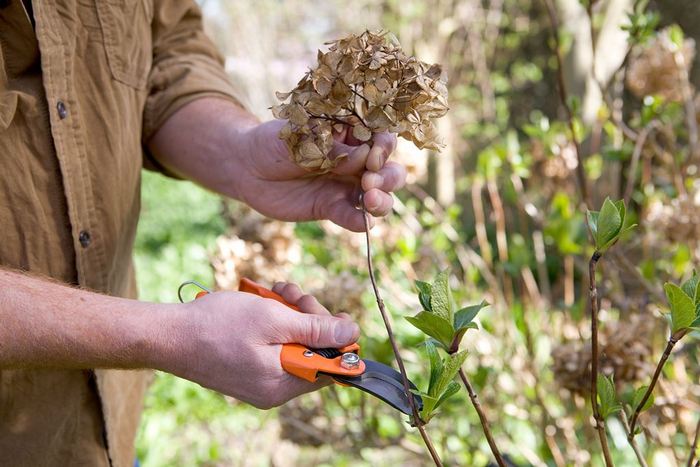

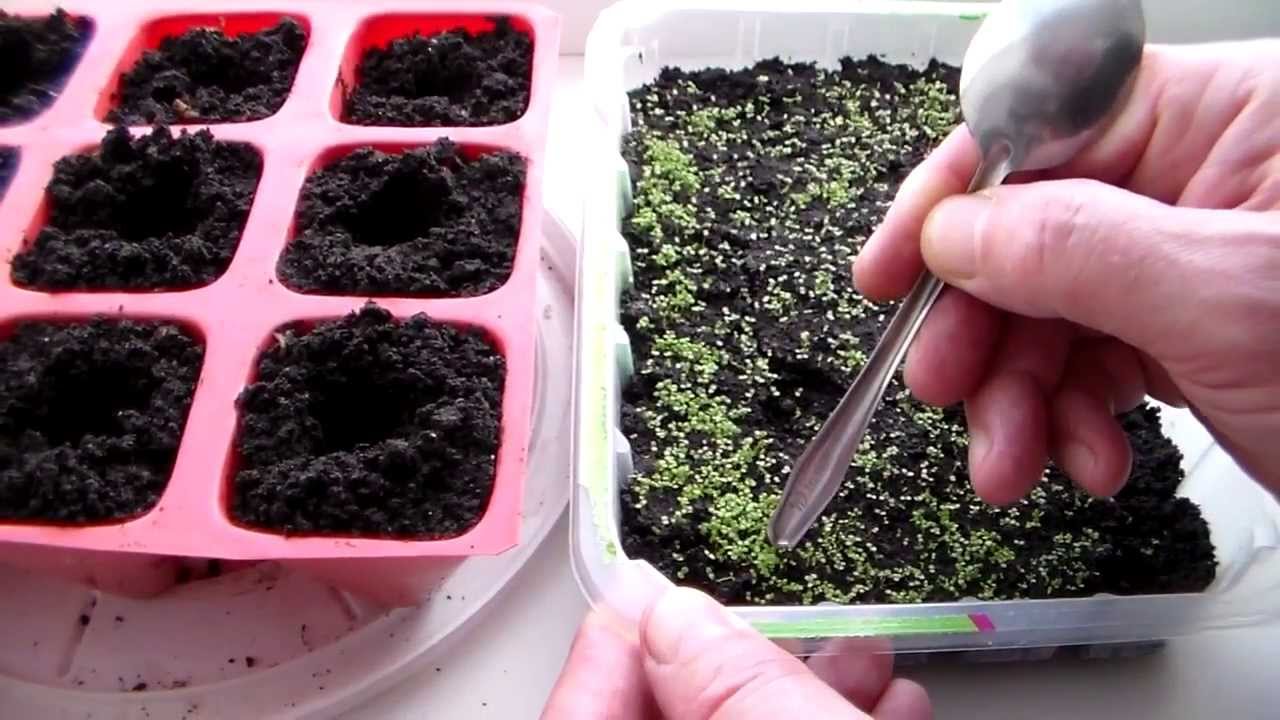


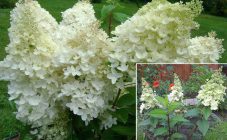
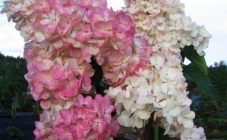
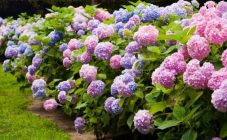
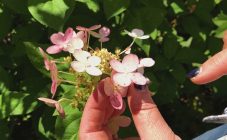
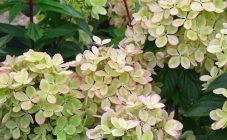







Panicle hydrangeas do not change color to blue, this is the prerogative of large-leaved hydrangea
I don’t understand whether the paniculata have already begun to tint, or is this the author’s fantasy? And why is the picture with tomatoes shown?